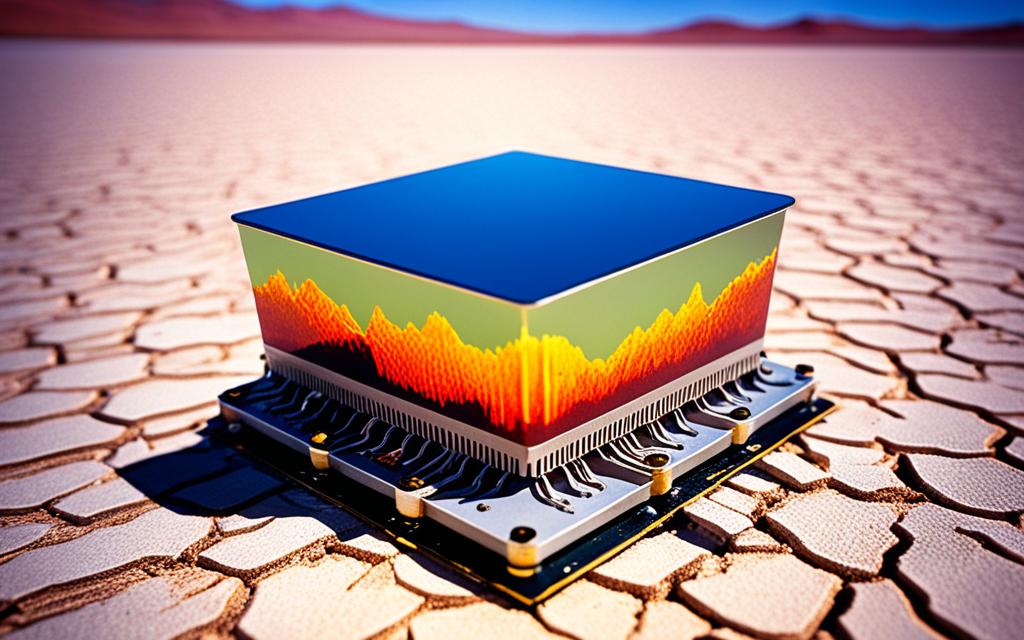Table of Contents
Knowing why your CPU gets hot when it’s not busy is key to keeping it running well for longer. Many ask, “why is my CPU temp so high at idle?” It’s a good question. A safe CPU idle temperature should be between 30°C (86°F) and 40°C (104°F) during light use1. But it can often be higher due to several reasons.
A too-hot CPU can cause big problems and might come from software and hardware issues. If your CPU often goes over 80°C (176°F), it can slow down and even get damaged over time1. So, figuring out why your CPU temperature is high is really important. This is especially true for those using Intel and Ryzen, as they react differently to heat.
Using monitoring tools like Core Temp or NZXT’s CAM helps you keep an eye on your CPU temperature. By doing this regularly, you can stop overheating and keep your computer running smoothly during heavy use.
Key Takeaways
- Normal CPU idle temperature ranges from 30°C (86°F) to 40°C (104°F).
- Consistent CPU temperatures above 80°C (176°F) indicate overheating risks.
- Regular monitoring is vital for maintaining ideal CPU temperatures.
- Different architecture CPUs (Intel vs. Ryzen) have varied temperature thresholds.
- Utilising software like Core Temp can help track temperature effectively.
Understanding CPU Temperature Measurement
Getting the CPU temperature measurement right is key for a computer’s performance and life span. Each CPU type shows different normal CPU idle temperatures. These are shaped by various factors. Knowing them helps avoid overheating problems.
What is a Normal Idle Temperature?
The usual range for a normal CPU idle temperature is 30°C to 45°C. This depends on the CPU’s design2. Intel chips, for example, might run from 40°C to 65°C when idle3. Some systems even report idle temperatures around 28°C under ideal conditions. This shows how room temperature affects CPU efficiency3.
Factors Affecting CPU Temperature Readings
Many elements can change CPU temperature readings. The air temperature around can really impact how hot your CPU gets3. How well your system cools itself, like fan speed, also plays a big part3. Plus, using your computer for tough tasks can make temperatures soar above 80°C2. It’s key to watch your CPU’s temperature, especially with high-demand apps, to keep it safe.
| CPU Model | Normal Idle Temp (°C) | Full Load Temp (°C) | Room Temp (°C) |
|---|---|---|---|
| Intel i7-9700K | 28 – 33 | 69 – 72 | 21 – 22 |
| Intel i9-8950HK | 40 – 65 | Up to 95 | Varied |
| Ryzen Model | Varies based on build | Varies based on load | Varied |
Being aware of how to measure CPU temperature well and manage your environment is vital. It keeps your computer running smoothly and avoids any performance hiccups234.
Common Reasons for High CPU Temperatures
High CPU temperatures can come from many factors. It’s vital to know these to keep your system running well. The main reasons for high CPU heat are background processes using up CPU power and poor system cooling.
Background Processes Consuming CPU Resources
Unwatched background processes can eat up CPU power without you knowing. These running apps can mess with your computer’s performance. They can make the CPU run hotter than it should. Normally, the CPU should be between 40–65°C (104–149°F). But, bad management can push it to 80–85°C (176–185°F) or more5. It’s important to check regularly to avoid damage.
Impact of System Overheating Due to Poor Ventilation
Good ventilation is key to keeping your CPU cool. Without it, dust can block airflow, making things worse. A healthy CPU should stay below 60°C (140°F). Yet, many computers get too hot, over 90°C (194°F), because of bad cooling. This overheating can harm your computer beyond repair. You must use effective cooling and keep air moving freely to avoid this.
| Temperature Range | Condition | Implications |
|---|---|---|
| 40–65°C (104–149°F) | Normal Workload | Safe operation for the majority of tasks. |
| 70–80°C (158–176°F) | Intensive Applications | Potential for overheating; requires monitoring. |
| 80–85°C (176–185°F) | High Risk | Possible damage if sustained over time. |
| Above 90°C (194°F) | Critical | Irrepressive damage may occur. |
Why is My CPU Temp So High at Idle
Knowing why your CPU gets hot even when it’s not doing much is key to keeping it running well. Different makes of CPUs, like Intel and Ryzen, act differently when they’re not busy. Finding out why can help us keep them cool and working smoothly.
Differences Between Intel and Ryzen CPUs
Intel and Ryzen CPUs don’t work the same way, which affects their temperature when idle. Ryzen CPUs are good at using many cores at once but might use just one when idle. This can make them run hotter than expected, leading to higher temperatures.
Software Issues Leading to Increased CPU Load
Software problems can also make your CPU work harder and get hotter. Unwanted programs or bad updates can make the CPU busy when it shouldn’t be. Using a program like Core Temp helps keep an eye on this7. Stay on top of updates and control background apps to keep your CPU cool5.
| Processor Type | Idle Temperature Range (°C) | Notes |
|---|---|---|
| Intel | 40-50 | Generally maintains lower idle temperatures due to efficient core management. |
| Ryzen | 45-60 | Higher idle readings may occur due to core load distribution. |
| Intensive Applications | 70-80 | Can lead to significant temperature increases under load. |
| Optimal Gaming Temp | 50-60 | Ideal for performance; check regularly with monitoring software. |
Potential Hardware Issues
High CPU temperatures during idle times often point to hardware problems that need fixing. Proper cooling and correct use of thermal paste are key for CPU cooler performance and keeping temperatures down. Issues with the cooling system or wrong thermal paste application can worsen heat removal. This leads to higher CPU temperatures.
The Role of CPU Coolers and Thermal Paste
CPU coolers are critical for keeping temperatures in check. Inefficient coolers or those filled with dust can block airflow, making temperatures rise. Cleaning the CPU cooler is important for keeping airflow and cooling efficiency up. This helps prevent overheating during less demanding activities. Also, putting on thermal paste correctly is crucial; not enough thermal paste means worse heat transfer from the CPU to the cooler. This leads to more heat building up. A very high CPU temperature when idle could cut the CPU’s lifespan by up to 40%, studies show8.
Power Supply Unit (PSU) Influence on CPU Temperatures
The PSU has a big impact on CPU temperatures. A PSU that gives out weak or erratic power can force the CPU to work harder than it should. This makes it use more power and heat up more. Changing power settings to balanced or energy-saving can help lower idle CPU temperatures8. Keeping the PSU free of dust is crucial too, as dust can lower performance and affect CPU temperatures directly. Fixing these hardware issues is vital for the system to work well and avoid getting too hot while idle.
How to Diagnose High CPU Temperatures
To find out why your CPU is getting hot, it’s key to watch how it works closely. You can use the Task Manager on Windows or the Activity Monitor on macOS to see what’s happening. These tools show which apps are making your CPU work harder and heating up.
Knowing what background apps are doing is vital. This understanding helps fix problems with high CPU temperatures.
Using Task Manager and Activity Monitor
When you open Task Manager, you see the CPU’s work in real-time. If you’re on Windows, just press Ctrl + Shift + Esc. Mac users have Activity Monitor for the same purpose. Spotting the apps that make your CPU hot is easier with these tools.
Identifying Unnecessary Background Applications
You can lower CPU heat by removing apps you don’t need. Some apps start on their own and use a lot of CPU, making it hotter. For example, you might need your antivirus but can turn off other apps’ auto-updates9.
Be careful when you stop certain apps from starting automatically. Some are important and fiddling with them could raise CPU temperatures. It’s a balancing act to manage your system well without making it overheat.
| Tool | Usage | Platform |
|---|---|---|
| Task Manager | Monitor CPU usage and terminate processes | Windows |
| Activity Monitor | View system performance and manage applications | macOS |
| Third-party Monitoring Software | Continuous temperature evaluation | Cross-platform |
Diagnosing high CPU temperatures begins with monitoring resource use via Task Manager or Activity Monitor.
Conclusion
It’s important to understand what causes high CPU temperatures when the computer is not busy. Knowing the design differences between CPU brands like Intel and Ryzen helps10. They can explain why some computers get too warm, with temperatures between 50-60 degrees Celsius, when they’re just idling. It’s also key to be aware of software problems. These can make the CPU work harder, even when it should be resting. This often leads to temperatures spiking, especially during intense activities10.
Keeping your hardware in good shape can help a lot. This means making sure your cooling system is working well and changing the thermal paste when needed. Doing so can bring down your laptop’s temperature by about 10-15 degrees Celsius. A cooler idle temperature, within 35-50 degrees Celsius, cuts down on overheating risks. This not only keeps your hardware safe but also makes your computer run more smoothly10.
To wrap up, following these tips can help you manage high CPU temperatures better. If you want to learn more about keeping your system stable and improving its performance, check out this detailed guide. With the right knowledge on CPU temperature control, you’ll enjoy a more dependable computing experience.
FAQ
What is considered a high CPU temperature at idle?
A CPU temperature that’s 10-15°C above the room’s for Intel, or 20-25°C for Ryzen, is high when idle.
How can I check my CPU temperature?
You can use tools like Core Temp or HWMonitor. Windows has Task Manager and macOS has Activity Monitor.
What are common software causes of high CPU temperatures?
High temperatures can occur from background processes eating up resources. Outdated browsers or apps that aren’t optimised can also cause this.
Can my CPU cooler affect temperature readings?
Yes. An ineffective cooler, a bad installation, or incorrectly applied thermal paste can raise CPU temperatures significantly.
What steps can I take to reduce high CPU temperatures?
Lowering high CPU temperatures can be done by closing unneeded apps. Also, improve system airflow, clean your PC, and check your cooling systems work well.
How do Intel and Ryzen CPUs differ in idle temperature management?
Ryzen CPUs might run hot as they use one core at idle. Intel spreads the load more evenly, keeping temperatures lower.
What role does the Power Supply Unit (PSU) play in CPU temperatures?
An inadequate PSU can lead to uneven power, making the CPU work harder. This overheats the CPU.
Why is it important to address high CPU temperatures?
Keeping CPU temperatures in check is vital for good performance and long system life. It ensures reliability and efficiency.
Source Links
- https://www.noyafa.com/blogs/knowledge-base/good-cpu-temperature – What Is A Good CPU Temperature? A Guide to Keep Your Processor Cool
- https://www.hwinfo.com/forum/threads/need-help-understanding-sensors-diagnosing-high-temperature-readings.9616/ – Need Help Understanding Sensors & Diagnosing High Temperature Readings!
- https://www.askwoody.com/forums/topic/high-cpu-temps/ – High CPU temps @ AskWoody
- https://www.dell.com/support/kbdoc/en-us/000131532/resolving-a-high-temperature-or-overheating-issue-on-alienware-notebooks-purchased-after-2016 – Resolving High CPU Temperature Issues on Alienware Laptops
- https://www.avast.com/c-how-to-check-cpu-temperature – How to Check and Monitor Your CPU Temperature
- https://www.pandasecurity.com/en/mediacenter/how-to-check-cpu-temp/ – How to Check Your CPU Temperature – Panda Security
- https://www.alcpu.com/CoreTemp/ – Core Temp
- https://softwareg.com.au/blogs/computer-hardware/cpu-temp-high-on-idle – CPU Temp High On Idle
- https://www.techpowerup.com/forums/threads/my-cpu-temperature-jump-on-idle.303098/ – My cpu temperature jump on idle
- https://forums.linuxmint.com/viewtopic.php?t=357671 – [SOLVED] High to critical CPU temp, despite low usage












